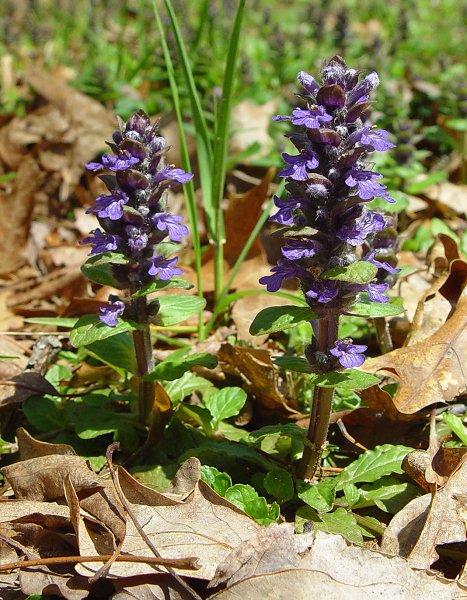Ajuga reptans L.
Carpet Bugle

Introduced
CC = *
CW = 5
MOC = 8
© DETenaglia
Ajuga reptans L.Carpet Bugle | |
 |
Introduced CC = * CW = 5 MOC = 8 |
© DETenaglia |
|
Family - Lamiaceae Habit - Fibrous-rooted, perennial forb.
Leaves - Leaves of vegetative stems petiolate, opposite, from 1.5-6 cm long, 1-3.5 cm broad, glabrous or sparsely pubescent. Leaves of flowering stems opposite, sessile to 2.5 cm long, 1.5 cm broad, toothed, entire, or irregularly crenate, oblong to obovate, pubescent, typically decussate in inflorescence, often with a strong coppery or purplish tint.
Inflorescence - Terminal spikelike racemes, cylindrical, typically with 6 flowers per node. Bracts leaflike, mostly longer than the flowers. Flowers sessile or on stalks to 1 mm.
Flowers - Calyces actinomorphic, to 5.0 mm long, bell-shaped, 5-lobed, the lobes as long as or somewhat longer than the tube, triangular. Corollas 12-20 mm long, zygomorphic, blue, the surfaces sparsely to moderately hairy, the tube funnelform, 2-lipped to about the midpoint, the upper lip reduced and inconspicuous, the lower lip prominent, mostly 4-lobed with 2 small lateral lobes and a large central lobe which is notched. Stamens 4, slightly exserted, the lower 2 stamens with slightly shorter filaments. Ovary relatively shallowly lobed, the style appearing more or less lateral from a shallow apical notch. Style exserted, more or less equally 2-branched at the tip.
Fruits - Dry schizocarps, often not separating into nutlets (or only tardily so) and often with only 1 or 2 of the ovules developing into fruits, these 1.5-2.0 mm long, oblong-obovoid, the surface brown, glabrous or sparsely short-hairy near the tip, with a prominent, honeycomblike network of ridges. Flowering - April - May. Habitat - Cultivated, sometimes escaping into lawns. Origin - Native to Eurasia. Lookalikes - None. Other info. - This plant is frequently cultivated as a hardy ground cover, and can be aggressive in gardens but usually does not escape far. It spreads by stolons and reseeds itself. The leaves and stems can be from green to deep purple in color, and quite variable in size, depending on the cultivar. Photographs taken in Brown Summit, NC., 4-12-03 (DETenaglia); also near Labadie, Franklin County, MO, 4-26-2015 (SRTurner). |